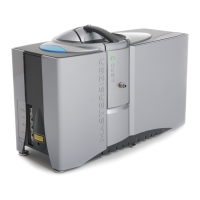Introducing the Mastersizer 3000 Chapter 2
Mastersizer 3000 Page 2-5
Typical systems
Wet dispersion
A wet system consists of the optical unit and either the Hydro LV/MV or EV dis-
persion unit. These dispersion units are designed to circulate a liquid sample
through the Mastersizer's measurement cell. Many materials need to be measured
as wet dispersions. Typically these are materials that are used or produced wet in
the manufacturing process or need to be dispersed in a liquid in order to achieve
reproducible dispersion.
Hydro LV/MV
The Hydro MV and LV units are designed to create a suspension of particles in
water or other liquid media. The Hydro LV can handle a liquid volume of 600ml,
whereas the Hydro MV unit has a volume of 120ml. Both can be configured to
automatically deliver liquid dispersants and also dispose of the sample following a
measurement. This enables the cleaning and filling of the units as part of an SOP.
The large capacity of the Hydro LV makes it ideally suited to the measurement of
samples which have very broad size distributions or contain large particles. In some
cases, sample materials are not plentiful and the MV's smaller volume sample dis-
persion unit is a sensible choice to minimize sample and dispersant consumption
while retaining the benefits of totally automated sample dispersion and measure-
ment.
Hydro EV
In the mineral, chemical, metal powder refining and cement industries, measure-
ments of larger sample volumes are often most appropriate for QC of the manufac-
turing process and finished product. The large capacity of this unit makes it ideally
suited to the measurement of such samples as well as larger materials having broad
size distributions.
The Hydro EV is a wet dispersion unit designed to circulate a liquid sample held
within a standard laboratory beaker through the Mastersizer's measurement cell. As
such the filling and emptying of this unit is a manual process.
Hydro SM
The Hydro SM enables the Mastersizer to be used for particle-in-liquid particle
sizing, where the amount of sample available limits the amount of dispersant that
can be used to dilute it, or where just a small volume of dispersant is available. This
is ideal when the sample or dispersant is toxic or expensive.

